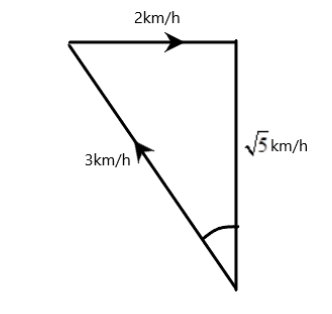
A man can swim in still water at a speed of 3 km/h. He wants to cross a river that flows at 2 km/h and reach the point directly opposite to his starting point. (a) In which direction should he try to swim (that is, find the angle his body makes with the river flows)? (b) how much time will it take to cross the river if the river is 500 m wide?
Answer
443.7k+ views
Hint To find the angle between the direction of swimming of the man and that of the bank, first find the angle between the direction of swimming and the vertical. Find the component of the swimming of the man to the vertical to find the time taken to cross the river.
Formula used: In this solution we will be using the following formulae;
\[v = \dfrac{d}{t}\] where \[v\] is the velocity of a body in a particular direction, \[d\] is the displacement traversed by the body in a direction, and \[t\] is the time elapsed for the displacement to be covered.
\[hy{p^2} = op{p^2} + ad{j^2}\] where \[hyp\] signifies hypotenuse side of a right angled triangle, \[opp\] is opposite side, and \[adj\] is the adjacent side.
Complete Step-by-Step solution:

To find the angle between the targeted velocity of the swimming of the man (3km/h) and that of the velocity of the river, we must calculate the angle \[\theta \] first. This can be calculated as in
\[\tan \theta = \dfrac{2}{3}\]
\[ \Rightarrow \theta = {\tan ^{ - 1}}\left( {\dfrac{2}{3}} \right) = 41.7^\circ \]
Now, since, the river flow is parallel to the river bank, then the angle the man should try to swim
\[\alpha = 90 + \theta = 131.7^\circ \]
To find the time taken to cross the river, we must find the actual velocity of the man. We can use Pythagoras theorem, which says
\[hy{p^2} = op{p^2} + ad{j^2}\] where \[hyp\] signifies hypotenuse side of a right angled triangle, \[opp\] is opposite side, and \[adj\] is the adjacent side.
Hence,
\[{x^2} = {3^2} - {2^2} = 9 - 4 = 5\]
\[ \Rightarrow x = \sqrt 5 km/h\]
Now, from the equation
\[v = \dfrac{d}{t}\] where \[v\] is the velocity of a body in a particular direction, \[d\] is the displacement traversed by the body in a direction, and \[t\] is the time elapsed for the displacement to be covered, we have
\[\sqrt 5 = \dfrac{{0.5}}{t}\] (since 500 m is \[0.5km\])
Hence,
\[t = \dfrac{{0.5}}{{\sqrt 5 }} = 0.22hr\] or \[13.4\] minutes.
Note: Alternatively, one could calculate the real velocity of the man by finding the component of the 3km/h on the vertical axis, as in
\[v = 3\cos 41.7^\circ = 2.23\]
This is equivalent to \[\sqrt 5 \]
Formula used: In this solution we will be using the following formulae;
\[v = \dfrac{d}{t}\] where \[v\] is the velocity of a body in a particular direction, \[d\] is the displacement traversed by the body in a direction, and \[t\] is the time elapsed for the displacement to be covered.
\[hy{p^2} = op{p^2} + ad{j^2}\] where \[hyp\] signifies hypotenuse side of a right angled triangle, \[opp\] is opposite side, and \[adj\] is the adjacent side.
Complete Step-by-Step solution:

To find the angle between the targeted velocity of the swimming of the man (3km/h) and that of the velocity of the river, we must calculate the angle \[\theta \] first. This can be calculated as in
\[\tan \theta = \dfrac{2}{3}\]
\[ \Rightarrow \theta = {\tan ^{ - 1}}\left( {\dfrac{2}{3}} \right) = 41.7^\circ \]
Now, since, the river flow is parallel to the river bank, then the angle the man should try to swim
\[\alpha = 90 + \theta = 131.7^\circ \]
To find the time taken to cross the river, we must find the actual velocity of the man. We can use Pythagoras theorem, which says
\[hy{p^2} = op{p^2} + ad{j^2}\] where \[hyp\] signifies hypotenuse side of a right angled triangle, \[opp\] is opposite side, and \[adj\] is the adjacent side.
Hence,
\[{x^2} = {3^2} - {2^2} = 9 - 4 = 5\]
\[ \Rightarrow x = \sqrt 5 km/h\]
Now, from the equation
\[v = \dfrac{d}{t}\] where \[v\] is the velocity of a body in a particular direction, \[d\] is the displacement traversed by the body in a direction, and \[t\] is the time elapsed for the displacement to be covered, we have
\[\sqrt 5 = \dfrac{{0.5}}{t}\] (since 500 m is \[0.5km\])
Hence,
\[t = \dfrac{{0.5}}{{\sqrt 5 }} = 0.22hr\] or \[13.4\] minutes.
Note: Alternatively, one could calculate the real velocity of the man by finding the component of the 3km/h on the vertical axis, as in
\[v = 3\cos 41.7^\circ = 2.23\]
This is equivalent to \[\sqrt 5 \]
Recently Updated Pages
Master Class 11 Accountancy: Engaging Questions & Answers for Success

Glucose when reduced with HI and red Phosphorus gives class 11 chemistry CBSE

The highest possible oxidation states of Uranium and class 11 chemistry CBSE

Find the value of x if the mode of the following data class 11 maths CBSE

Which of the following can be used in the Friedel Crafts class 11 chemistry CBSE

A sphere of mass 40 kg is attracted by a second sphere class 11 physics CBSE

Trending doubts
10 examples of friction in our daily life

Difference Between Prokaryotic Cells and Eukaryotic Cells

One Metric ton is equal to kg A 10000 B 1000 C 100 class 11 physics CBSE

State and prove Bernoullis theorem class 11 physics CBSE

What organs are located on the left side of your body class 11 biology CBSE

Define least count of vernier callipers How do you class 11 physics CBSE




